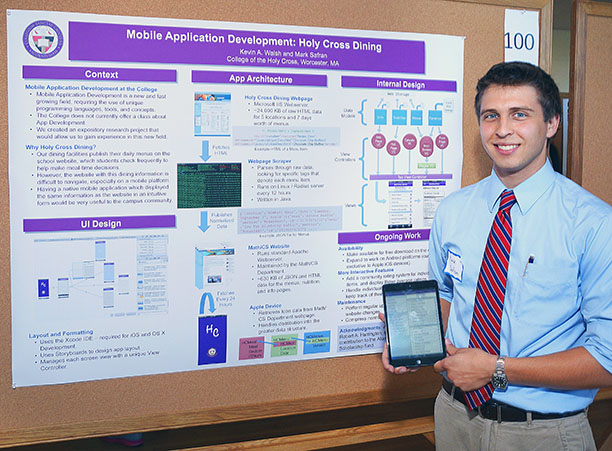 In October 2013, Apple announced that it had more than one million apps available for download in its app store, many written by independent developers. One of those apps was created by Mark Safran ’15, a computer science major and Russian minor at the College of the Holy Cross. Safran, of Closter, N.J., spent his summer working with Kevin Walsh, assistant professor of mathematics and computer science, to develop the app that now allows students to easily see menu items in each of the College’s five dining areas on campus along with their respective nutritional content.
In October 2013, Apple announced that it had more than one million apps available for download in its app store, many written by independent developers. One of those apps was created by Mark Safran ’15, a computer science major and Russian minor at the College of the Holy Cross. Safran, of Closter, N.J., spent his summer working with Kevin Walsh, assistant professor of mathematics and computer science, to develop the app that now allows students to easily see menu items in each of the College’s five dining areas on campus along with their respective nutritional content.
“The ‘Holy Cross Dining App’ takes the same menu and nutritional information available on the Holy Cross website and reproduces it in a simple, user-friendly mobile application,” said Safran. “The data for the week is downloaded from the website once a day and stored in a local file on the mobile device, which makes checking ‘What’s for dinner?’ quick and easy.”
Safran, who is in the College Honors Program, and his friends had for months discussed the idea of an app, and the opportunity to write the program presented itself through the summer research program. Safran, who also works as a lab assistant supporting an introductory computer programming course taught by Walsh, spent the first few weeks of the summer learning how to develop simple apps for the Apple iOS platform and experimenting with the unique coding techniques used in that development environment. Once mastered, he developed a storyboard for the visual layout of the app, and he began to design data structures and modifying a code written by Ryan Hallisey ’14, also a computer science major, to make the app interactive.
“Toward the second half of the summer, once Mark had gotten deep into programming the app, we would often work together in the lab,” said Walsh. “Mark would show me his code or talk about his plans, and I'd critique, ask questions, and make suggestions.”
The final stages of summer work involved developing a program to automatically pull data from the Dining Services website, converting it into a format that could be easily plugged into the app. Daily menus and nutritional information have been available on the Holy Cross Dining website for more than five years and are kept up-to-date through a collaboration between Holy Cross dietician Kathy Egan, R.D., and Marty Dudek, associate director of production and purchasing, to ensure that the most current and accurate information is available, especially in regards to allergens.
“We know how important this information is to our students, especially to those with food allergies,” said Linda Nardella, director of Holy Cross Dining. “Being able to provide this information to the community in as many formats as possible has been wonderful. We're always happy to work with our very talented students and benefit from their knowledge and expertise.”
“Once we plugged this ‘live’ data into our iOS code, the app was essentially finished in its basic form,” said Safran. “We spent the last two weeks or so error checking, beta testing functionality on several devices, and polishing up the code.” After consultations with offices on campus to ensure accuracy, branding, and consistency with the College identity, the app was published to Holy Cross’ official channel on Apple’s iOS App Store and is now available for free download.
“Not many students get the chance to do mobile app development or to really see every side of a project like this — from initial brainstorming, to planning, then design, development, testing, and now finally releasing it to the public,” said Walsh. “Mark also learned a lot of new technologies along the way.”
This research project was funded by Robert A. Harrington, M.D. ’82 and his wife, Rhonda L. Larsen. Their donation through the Alumni/Parent Summer Research Scholarship fund provided Safran a weekly stipend and a supply budget for his research, in addition to room and board. Each summer science research fellowship costs $7,000 to fund, and more than 70 students participate in research projects each summer.
Related Information
Related News
- Worcester Magazine, Dec. 26; 'Holy Cross Student Develops App'
- Students to Showcase Their Accomplishments at 20th Annual Summer Research Symposium
- Summer Research Program
- Mathematics and Computer Science